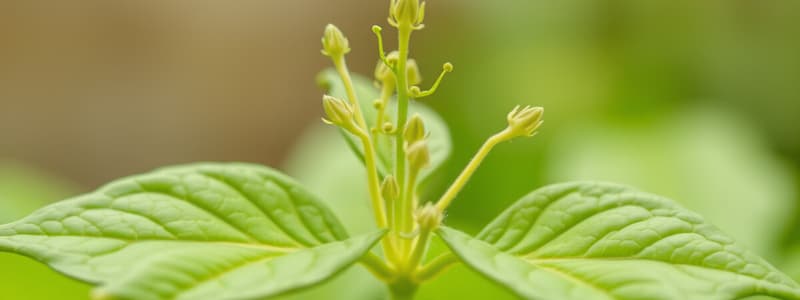Podcast
Questions and Answers
What is the primary role of auxin in plants?
What is the primary role of auxin in plants?
- Inhibits cell division
- Promotes fruit and shoot growth (correct)
- Aids in stomatal closure
- Stimulates leaf loss
Which hormone is primarily responsible for promoting cell division in plants?
Which hormone is primarily responsible for promoting cell division in plants?
- Abscisic acid
- Auxins
- Cytokinins (correct)
- Gibberellins
What is the effect of gibberellins on plant growth?
What is the effect of gibberellins on plant growth?
- Stimulates elongation of shoots (correct)
- Closes stomata
- Inhibits shoot elongation
- Promotes leaf wilting
Which hormone causes dormancy in seeds and promotes leaf fall?
Which hormone causes dormancy in seeds and promotes leaf fall?
How do plants primarily respond to environmental changes?
How do plants primarily respond to environmental changes?
What term describes the movement of a plant towards a stimulus?
What term describes the movement of a plant towards a stimulus?
What effect do cytokinins have on aging in leaves?
What effect do cytokinins have on aging in leaves?
What happens to auxin concentration when light is directed towards one side of a plant?
What happens to auxin concentration when light is directed towards one side of a plant?
Plants coordinate their behaviour against environmental changes by using ______.
Plants coordinate their behaviour against environmental changes by using ______.
Auxin is synthesized in the young shoot tip to promote fruit and ______ growth.
Auxin is synthesized in the young shoot tip to promote fruit and ______ growth.
Gibberellins help in breaking the ______ in seeds and buds.
Gibberellins help in breaking the ______ in seeds and buds.
Cytokinins promote ______ division in plants.
Cytokinins promote ______ division in plants.
Abscisic acid helps in stomatal ______ and causes dormancy of seeds.
Abscisic acid helps in stomatal ______ and causes dormancy of seeds.
The movement of plants in direction of stimulus is known as ______.
The movement of plants in direction of stimulus is known as ______.
Tropic movement occurs when the stimulus has a particular ______.
Tropic movement occurs when the stimulus has a particular ______.
Auxins promote cell ______ and cell differentiation in plants.
Auxins promote cell ______ and cell differentiation in plants.
Flashcards are hidden until you start studying
Study Notes
Plant Hormones and Their Functions
- Plants lack a nervous system and sense organs but can sense environmental changes through hormones.
- Coordination of behaviors in plants is achieved using four major types of plant hormones (phytohormones).
Auxin
- Synthesized in the young shoot tip to promote growth in fruits and shoots.
- Diffuses towards the darker side of the shoot when exposed to directional light, causing cells to elongate and the shoot to bend towards the light.
- Plays a role in cell enlargement and differentiation.
Gibberellins
- Promote cell enlargement and differentiation, particularly in conjunction with auxins.
- Break dormancy in seeds and buds, facilitating growth.
- Primarily involved in shoot elongation and fruit growth.
Cytokinins
- Stimulate cell division and growth in plants.
- Help break the dormancy of seeds and buds while delaying leaf aging.
- Encourage stomatal opening and contribute to fruit development.
Abscisic Acid
- Functions as a growth-inhibiting hormone.
- Aids in stomatal closure and induces dormancy in seeds.
- Associated with leaf drop and loss of protein and chlorophyll content.
Tropisms (Tropic Movements)
- Plants demonstrate sensitivity by detecting changes and responding accordingly.
- Tropism refers to the directional movement of plants in response to stimuli.
- Positive tropism: Growth or movement towards the stimulus.
- Negative tropism: Growth or movement away from the stimulus.
Plant Hormones and Their Functions
- Plants lack a nervous system and sense organs but can sense environmental changes through hormones.
- Coordination of behaviors in plants is achieved using four major types of plant hormones (phytohormones).
Auxin
- Synthesized in the young shoot tip to promote growth in fruits and shoots.
- Diffuses towards the darker side of the shoot when exposed to directional light, causing cells to elongate and the shoot to bend towards the light.
- Plays a role in cell enlargement and differentiation.
Gibberellins
- Promote cell enlargement and differentiation, particularly in conjunction with auxins.
- Break dormancy in seeds and buds, facilitating growth.
- Primarily involved in shoot elongation and fruit growth.
Cytokinins
- Stimulate cell division and growth in plants.
- Help break the dormancy of seeds and buds while delaying leaf aging.
- Encourage stomatal opening and contribute to fruit development.
Abscisic Acid
- Functions as a growth-inhibiting hormone.
- Aids in stomatal closure and induces dormancy in seeds.
- Associated with leaf drop and loss of protein and chlorophyll content.
Tropisms (Tropic Movements)
- Plants demonstrate sensitivity by detecting changes and responding accordingly.
- Tropism refers to the directional movement of plants in response to stimuli.
- Positive tropism: Growth or movement towards the stimulus.
- Negative tropism: Growth or movement away from the stimulus.
Studying That Suits You
Use AI to generate personalized quizzes and flashcards to suit your learning preferences.




